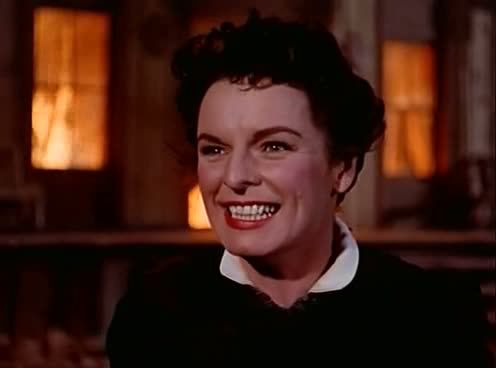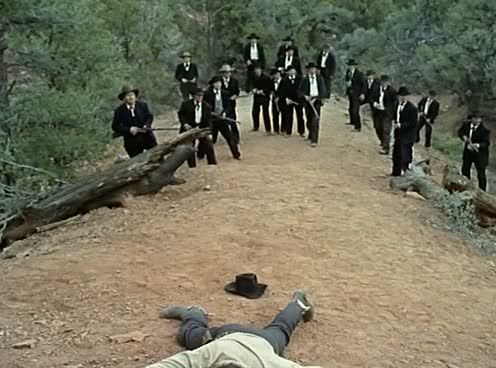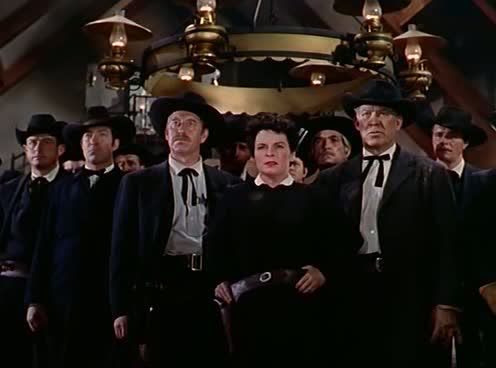

Nicholas Ray's Johnny Guitar is a fantastic, lurid Western, a drama of sexual repression and desire played out with bullets and lynchings, the struggle for power between two rival women exploding into a bloody, bleakly beautiful morality tale. The film's central struggle is the battle of feminine strength between Vienna (Joan Crawford) and Emma (Mercedes McCambridge), two driven women with diametrically opposed personalities. Vienna takes what she wants, and through her strength, her determination — and, it's implied, her willingness to use her sexuality as a tool when she needs to — she's put together a saloon that's isolated right now, in the middle of nowhere, but that will soon be at an important hub on the expanding railroad that's scheduled to run right through Vienna's territory. She's made her own way in the world, and now all she needs to do is sit in her lonely saloon and wait for the railroad to come, bringing with it the people who will make her rich. Emma is also a woman with power and money, but it's not her own; her family owns a bank and has power in the nearby town, which means that the men of her family have gotten Emma what money and prestige she has. More crucially, Emma differs from Vienna in her sexual confidence and security; Emma wants the quasi-outlaw known as the Dancing Kid (Scott Brady), though she'd never admit it, and Vienna has the Kid but doesn't really want him. Emma's jealousy, and the sexual repression that causes her to deny her obviously overwhelming desires, creates the fierce rivalry between the two women, a rivalry that will eventually be stirred up into a conflagration, both literal and metaphorical, that threatens to turn everyone in its path to ash.
Into this tense situation rides the drifter Johnny Guitar (Sterling Hayden), who at first seems like a detached stranger. Johnny Guitar rides into town, and into the movie that bears his name, not as an actor in this drama but as a witness: he sees, much like the audience, the railroad company setting off dynamite, and he sees, from a distance, a stagecoach getting robbed, and then he rides up to the lonely saloon in the middle of nowhere, isolated in a swirling dust storm. He's a witness, an audience, watching from a comfortable distance, just as the film's audience watches over his shoulder. When he then enters the story, it's as though he's breaking out of his passivity, abandoning the position of the observer to engage with the action and to try to change its course — reflecting the fantasy of engaging so deeply with a film or a work of fiction that one becomes a part of its world. It's fitting that Johnny's entry into the drama at the saloon is his interruption of a shot glass in its rolling path towards the edge of the bar. He steps into the frame, with a tea cup held daintily aloft, and catches the glass just as it drops off the bar, irrevocably changing what had seemed inevitable, introducing an unexpected element into the proceedings. He's no longer the audience, passively looking on with a drink in his hand; now he shuttles between the two sides of the confrontation in the saloon, tweaking them both, acting as the wild card who's entered the story from outside it. Later, during a bank robbery, Johnny will revert to his audience role: "looks like I got a front row seat for the show," he quips to the robbers, lounging against his cart, his hands in his pockets. He's a study in passivity versus action, and for long portions of the movie he disappears altogether, incidental to the real emotional and aesthetic core of this movie.

Vienna, on the other hand, is pure action, and though the film bears Johnny's name, it's really Vienna's movie — and Emma's. As Vienna finds herself caught up in the Dancing Kid's ill-advised plan to belatedly live up to his unearned reputation as an outlaw and robber, Emma stirs up the entire town into a fearsome but aimless lynch mob that's ostensibly searching for the bank robbers but is in fact, under Emma's direction, being aimed like a weapon towards the bitter woman's sexual rival. The entire mob, still dressed in black from a funeral, swarm on their horses through the bleak surroundings, spurred on by the black-cloaked Emma, who's like an avenging harpy with her teeth bared, snarling and insinuating, goading the men into terrible action, her face flushed with rage and vindictiveness. And when she gets her way she can't help but grin, the grin of the damned, an evil but joyous grin, girlishly skipping as she spurs on her followers towards death and destruction. Ray makes her a monster, a demon in black, her mourning shawl dropped from her head at the very beginning of the chase, the purpose — or the justification — for all this chaos almost immediately forgotten and replaced with a feverish sexual hysteria.
It's a mad film, but its intense emotions are carefully controlled within a very rigid and powerful aesthetic framework. These oversized emotions, these bold feelings and words freighted with meaning, are straining against the boundaries of the Academy ratio frame, against the very form of the film which seeks, in vain, to hem them in. This tension is embodied in the jarring leaps between natural splendor and studio artificiality, necessitated at least in part by star Joan Crawford, a solidly artificial actress who refused to be filmed in closeup in nature. That might be a crippling limitation for a Western, except that Ray makes it into a weird virtue, adding to the impression that Vienna is always in control while Emma spirals into deranged hysteria. Vienna's saloon is cool and clean, almost clinical, its color scheme a uniform reddish brown, its large, high-ceilinged rooms almost always empty. When Vienna is filmed in closeups, they're glossy, beautiful images, the light shining almost entirely on her face so that her head glows like a spotlight in the dark void around her, the shadows falling so closely around her face that at times, when she moves even slightly, the lower or upper portion of her face melts into the shadowy surroundings.
Moreover, Vienna — or Crawford — carefully coordinates her costume changes to augment her surroundings. It's even made a material part of the film, as she's forced to change out of her bright white dress during a night-time flight from the posse, who are more sensibly dressed in their funereal blacks to blend into the darkness. With the change, Vienna opts for dark blue pants to blend into the Hollywood night, and a red blouse that initially seems as ill-advised as the white dress until one sees Vienna positioned amidst the similarly reddish studio rocks of the surrounding countryside. In the wild, she'd stick out absurdly; in the garish studio West where she's most comfortable, she's a chameleon.


Obviously, color and costume are very important to this film, from Vienna's color-coded outfits to the black suits of the mourners who comprise the posse. The posse is constantly arranged into densely packed compositions in which they crowd the frame, forming threatening triangles aimed at Vienna, often with Emma at the point. Towards the end of the film, with the threat dissipated, that triangle will reverse, at last pointing away from Vienna, grouped around the dead and the survivors, providing a corridor for Vienna's exit. The awful geometry of sexual repression had closed in on her, but by the end of the film the geometry reconfigures to provide a way out. All of the artifice, the blatantly fake sets that Ray makes no attempt to integrate convincingly with the naturalistic outdoor scenes, contribute to the impression that Vienna, with her melodramatic persona, her expressive eyebrows and bright red lips, is a kind of mythic figure, with Emma as her opposite number. The two seem to be locked in a bigger-than-life combat, like two goddesses who have come to Earth and penetrated the usually masculine realm of the Western as the grounds for their confrontation. Indeed, during the grand finale, the men make a big point of calling off their own battles: all the men stop shooting to allow the two women to have their final showdown and shootout, an almost unheard-of gender reversal of the usual Western climax.
Indeed, this Western is actually a melodrama in genre drag, especially since Vienna keeps switching back and forth between long, flowing, feminine gowns and more manly gunslinger clothes. Her counterpart, Emma, on the other hand, remains in her funeral black for the bulk of the film, and in contrast to Vienna's carefully lit studio closeups, Emma is captured in increasingly frazzled states of derangement and disarray. As Vienna maintains her self-possession even in her moments of the most melodramatic emotional excess, Emma snarls and spits like an animal, her hair growing disheveled around her head, her teeth constantly exposed in a smile that looks like a grimace.
McCambridge, like Crawford, delivers an intense and raw performance in a film that's full of them, surrounded by other memorable performances from actors like Ward Bond, Ernest Borgnine and John Carradine, all of whom turn in appropriately gritty and meaty performances, and all of whom get their moment to shine. Carradine's Tom, who works in Vienna's saloon and mostly goes unnoticed by everyone, gets a surprisingly moving final scene that abruptly brings him into sharp focus. Ironically, only Hayden, as the title character, is stiff and uncharismatic, not quite getting into the melodramatic spirit of things. It hardly matters, though, because this is a Western where the women are, for a change, at the center of it all. What makes the film great is that Ray, while indulging the excesses and the weird humor of this story at times, also takes it very seriously, infusing every frame of the film with the potent sexual and gender subtexts that drive it to ever greater heights of emotional intensity and aesthetic overload.
Johnny Guitar is indeed a wonder. But wonderful as it is, it's not quite the movie Ray wanted to make -- and the reason for that is Joan Crawford. Try and scare up a copy of Gavin Lambert's "The Slide Area." One of the chaprters of that marvelous collecion of thematically connected staories, "The Closed Set," is about . The film it describes isn't Ray's film but the story is all about an imperiosu star refusing to cooperate with her director in any way.
ReplyDeleteWhen Gavin came to Hollywood to work with Ray, the first thing he witnessed was the shooting of Johnny Guitar -- and thus this marvelous tale a clef
"Indeed, this Western is actually a melodrama in genre drag, especially since Vienna keeps switching back and forth between long, flowing, feminine gowns and more manly gunslinger clothes."
ReplyDeleteHa! I must say I love this great idea, as I do the entire piece and soaring final sentence. It's often seen as an existential western, and a campy homage to Lang's RANCHO NOTORIOUS (a film I just recently saw at a festival). The "Freudian femisnism angle was exhaustively posed by Andrew Sarris, but most critics bought into the idea that Ray was going after the McCarthy mob hysteria with his subversive send-up of conservative political conventions. It's a baroque piece, and you are right to point to the importance of color, costume and decor to accentuate the themes you so well delineate here. Your discussion of the sexual repression in the film is brilliant. This is definitely one of Ray's greatest works. It's too bad we've yet to see a DVD that negotiates the proper color, an element so vital to the film's vision and artistry.
Nice additional info about Crawford, David. I'd heard that she resisted doing closeups anywhere but in the studio, which certainly hints at a troubled relationship between star and director, and your story confirms that. Ray seems to have worked around these difficulties in very inventive ways and even worked them into the film's structure and aesthetic.
ReplyDeleteSam, yeah, this was probably a jab at McCarthy, and also at conservative sexual politics in general, and in the latter regard its band of black-cloaked harpies on horses, out to destroy and suppress all sexual expression, remains as relevant today. Definitely agreed that this film deserves a better DVD too. The version I saw was watchable but it obviously needs a major upgrade badly.
Here in the UK we have a perfect dvd release, out for a few years now, with of course the obligatory introduction by Marty Scorsese!
ReplyDeleteThis was though the first film I was taken to as a child - I must have been 8 and it was an incredibly vivid exciting experience. What an introduction to cinema... I was fascinated by the story of the two women fighting, one about to be hanged, wearing the white dress. Years later I saw it again on television and realised it was the film I had first seen. It's been a staple ever since.
Thanks for the info, Michael, I'll have to check out the UK DVD. And you're right - what a great film to see as one's first! Vibrant, exciting, potent in ways that, I'm sure, even an 8-year-old could sense if not understand.
ReplyDelete